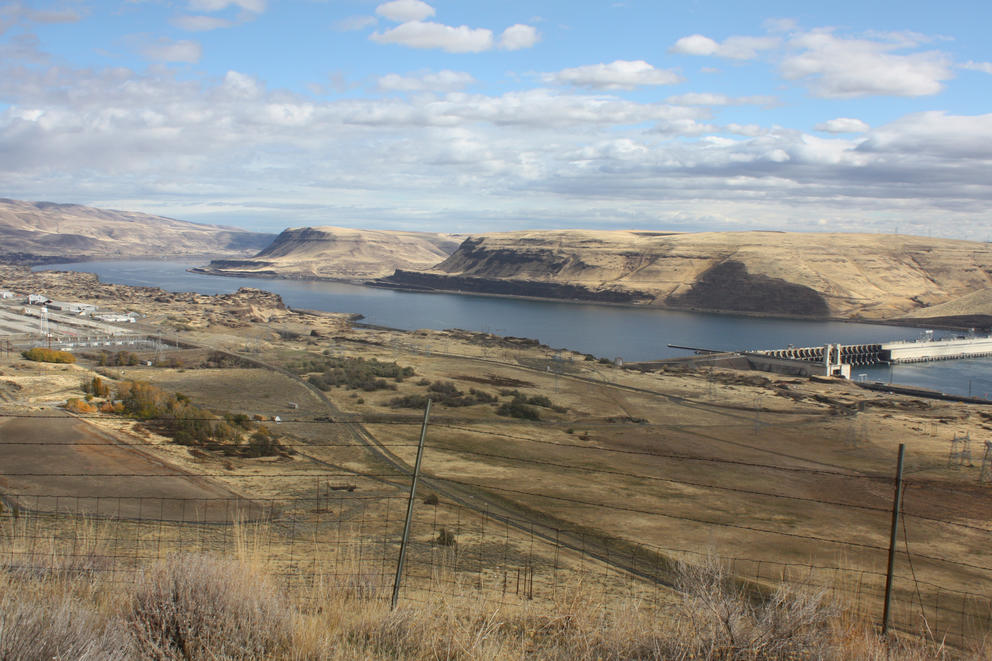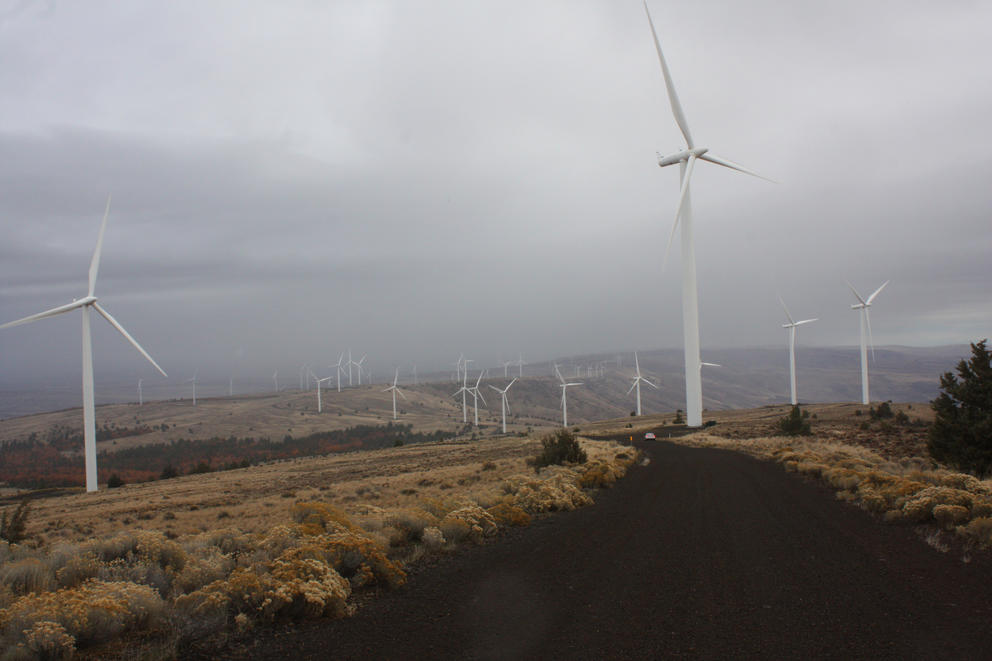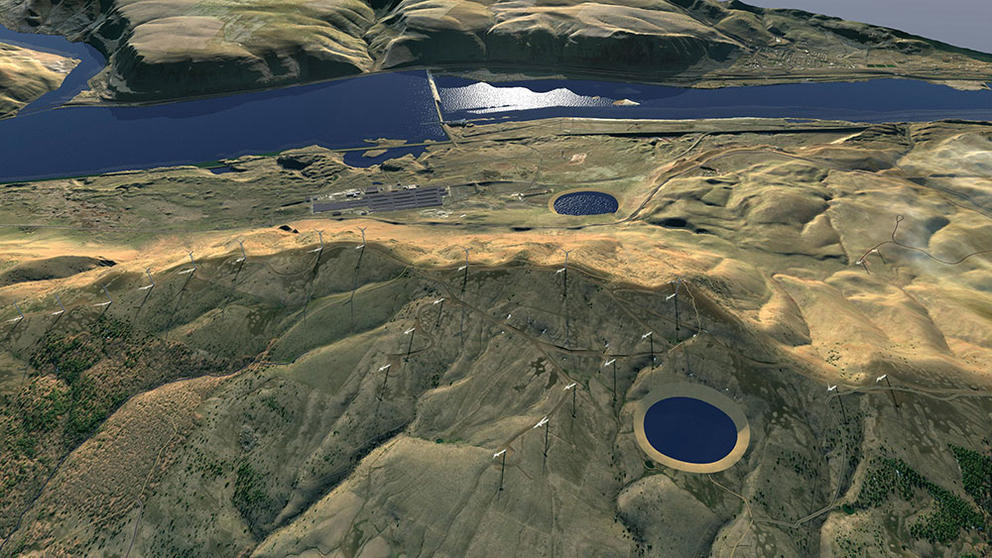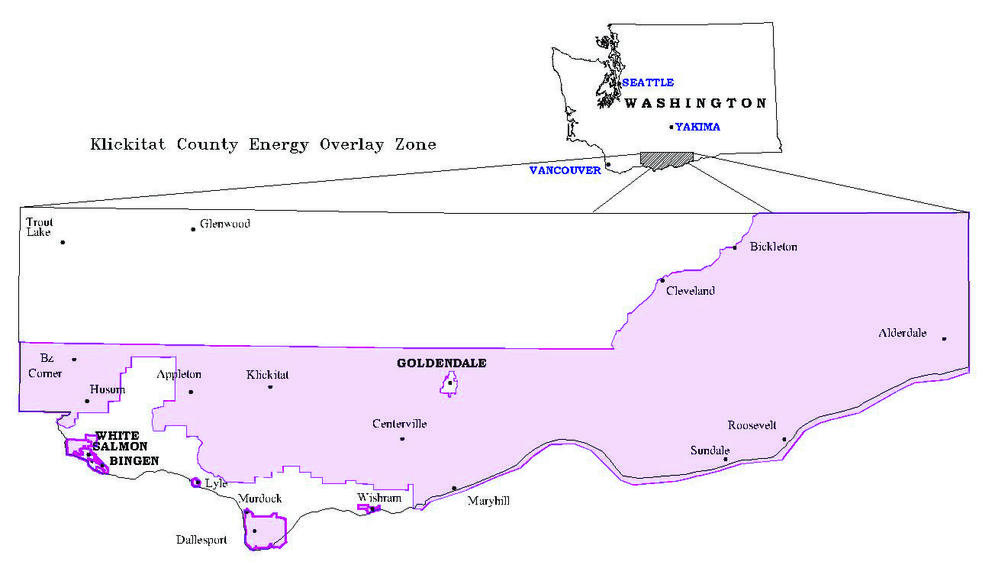The concept, called “pumped storage,” works similarly to a hydroelectric dam without killing salmon or keeping them from their spawning grounds.
It would be nestled between two rows of wind turbines and, while the idea may be environmentally promising, the proposed location of the project is getting pushback. The Yakama Indian Nation considers the site sacred and the tribe wants to protect it.
Rye Development of Boston is hoping to build Washington’s first pumped storage project for $2 billion in southern Klickitat County near the John Day Dam and having it in operation between 2028 and 2030.
The project would include two lined 600-acre water reservoirs that are 60 feet deep and separated by 2,100 feet in elevation. One reservoir would be on the river shore and the other at the top of a cliff. An underground pipe would connect the two reservoirs with a subterranean electricity generating station along the channel. Water would flow from the upper reservoir to the lower one to power the four-turbine generator station and then would be pumped back up to the upper reservoir in a closed-loop system.
The project is supposed to generate 1,200 megawatts of power, capable of providing electricity for roughly 500,000 homes, said Erik Steimle, Rye’s vice president of development. The Columbia Generating Station reactor next to Richland provides 1,250 megawatts. The John Day Dam produces 2,160 megawatts.
Steimle contends that this pumped storage project’s electricity production would equal 7,000 acres of wind turbines or 50,000 acres of solar power generating panels. Rye Development would buy its water from the Klickitat County Public Utility District.
A pumped storage operation complements wind turbines and solar farms, since its output can be stored to provide electricity on cloudy days and windless days, Steimle said.
The world’s first pumped storage hydroelectric project went online in 1907 in Switzerland.The first such project in the United States was built in 1929 in Connecticut. Today, the U.S. has 42 pumped storage hydropower sites producing roughly 29,000 megawatts of electricity, slightly more than 2% of the nation’s power, according to a 2018 report by the National Hydropower Association.
Fifty-three other projects totaling almost 26,000 megawatts are in various stages of obtaining federal, state and local permits. It takes a pumped storage project three to five years to obtain all the appropriate permits, the 2018 report said.
The two largest pumped storage operations in the U.S. are a 3,000 megawatt site in Virginia and a 1,862 megawatt site in Michigan. Switzerland, Austria, Portugal and Japan are the leading countries in using pumped storage.
The Klickitat County project is on private land that Rye Development leases from NSC Smelter, which owns the Columbia Gorge Aluminum smelter site one mile upstream from the John Day Dam before the smelter was torn down.
The land is within a huge strip in southern Klickitat County that the county has zoned for renewable energy projects. The county has 10 wind turbine projects operating or being constructed in the area today, totaling 602 individual turbines, mostly on private land. A 150 megawatt solar panel power generation farm also is under construction, while a 100 megawatt solar panel farm is going through the permitting process, said Dave McClure, the county’s director of economic development.
While the project is not on Yakama reservation land, it is on property used for sacred ceremonies and has an historical connection to the tribe. The project area includes a longhouse, an ancient village site and other sacred sites. Since 1855, the tribe has treaty rights to fish and hunt in the area, as well as the right to protect burial ground and religious sites across a vast area in south central and southeastern Washington.
Although Yakama tribal leaders did not respond to several Crosscut phone messages and emails requesting an interview, the tribe has expressed its opposition to the project in other ways.
In an Oct. 6 press release from the Yakama Nation, tribal leaders explained that this area is known to tribal members the as “Pushpum,” a sacred site for ceremonies, legends and the gathering of traditional roots and medicine for many generations, George Selam, tribal council cultural committee chair, said in the news release.
“For generations, regional utility infrastructure has been developed in the Yakama Nation's treaty territory, blasting customary fishing sites, flooding traditional villages, and seeping radioactive pollution (from Hanford) into subsistence and medicinal root fields," said Yakama Tribal Councilman Jeremy Takala, in the release.
Tribal Council Vice Chairman Virgil Lewis said he expects that in the next decade the Pacific Northwest will be pressured by the energy industry to allow more infrastructure development.
“This new technology must be developed ethically without destroying the cultural resources and gathering sites that are part of the Yakama way of life,” Lewis said.
Columbia Riverkeeper, the Washington chapter of the Sierra Club, American Rivers and the Washington Environmental Council have joined the Yakamas in opposing the project. A coalition of 15 environmental groups wrote a letter to state elected officials in Washington and Oregon to oppose the project.
“The greenwashing ends today,” stated Simone Anter, staff attorney for Columbia Riverkeeper. “Rye’s proposal would have devastating impacts on Tribal Nations and Indigenous people. The project also threatens local wildlife like bald and golden eagles. We are calling on Northwest leadership to honor Tribal Nations’ treaty rights and oppose this short-sighted venture.”
Recently, the Yakama Nation has voiced concerns more frequently about renewable energy projects showing up on ceded lands in Klickitat County, McClure said.
Steimle said Rye Development wants to work closely with the Yakama Nation and wants to respect its values. The company and the Yakamas have begun discussions on the topic.
Rye Development is the first company to pursue the pumped storage concept in the Pacific Northwest. Besides the Klickitat County project, Rye Development is developing a similar 400 megawatt pumped storage project at Swan Lake in southern Oregon. That $800 million project is scheduled to go online in 2026.
The Klickitat and Swan Lake projects are Rye Development’s first ventures into pumped storage. The company has 22 projects east of the Mississippi River that involve converting nonpowered dams into hydroelectric dams.
The Klickitat project is halfway through a state Environmental Policy Act review and is advancing toward a Federal Energy Regulatory Commission permit. In June, the Washington Department of Ecology rejected Rye Development’s application for a water quality permit due to insufficient information. But the state is allowing the company to resubmit the application.
The Klickitat project still faces two environmental hurdles.
One is the former aluminum smelter at the lower reservoir site that various corporations operated from 1969 to 2003. Smelter operations contaminated the site’s soil and groundwater with fluoride, polycyclic aromatic hydrocarbons, cyanide and polychlorinated biphenyls. Rye’s development plans would deal with that pollution, which Steimle expects will cost about $10 million.
The second hurdle is noted by the Washington Department of Fish and Wildlife in its comments on Rye Development’s state permit application. Golden and bald eagles fly about in Klickitat County. The wildlife department’s written comments said the upper reservoir would attract thirsty eagles into an area filled with wind turbines with spinning blades that might prove fatal to some birds.







